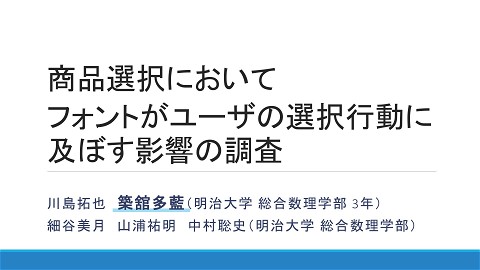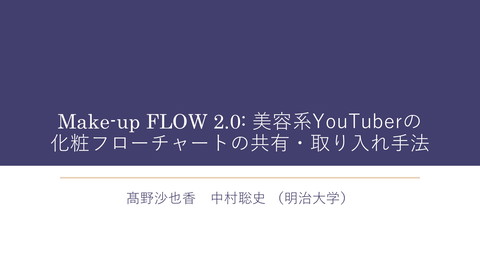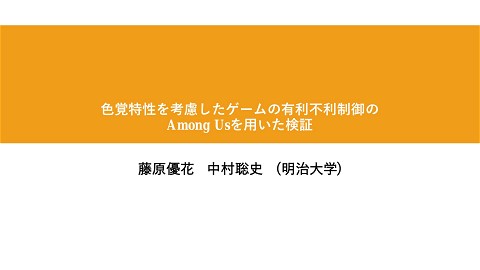Does the Average Color Influence Selection?
393 Views
August 03, 23
スライド概要
明治大学 総合数理学部 先端メディアサイエンス学科 中村聡史研究室
関連スライド
各ページのテキスト
Does the Average Color Influence Selection? Yuto Sekiguchi Riho Ueki, Kouta Yokoyama, Satoshi Nakamura 1
Q. Which of these “royal copenhagens” would you choose to buy? Red Purple Blue 2
Major Objectives To clarify and solve the unfairness UIs in product selection and popularity voting 3
Introduction People make many choices in daily life I'm having a tough time deciding… 4
Introduction People make many choices in daily life People are influenced by a variety of factors I'm having a tough time deciding… 5
Introduction Examples of Factors Taste Placement Price $20 Fragrance $25 Character Fonts Smorrebrod Quantity Smorrebrod 6
Introduction Examples of Factors Taste Placement Price Fragrance Among these various factors, we focused on colors. $20 $25 Character Fonts Smorrebrod Quantity Smorrebrod 7
Related Work Influence of Color in Product Selection ✓ Product color has a significant impact on selection decisions in product selection. [Priluck+ 1999] Priluck Grossman, R., Wisenblit, J. Z.: What we know about consumers’ color choices. Journal of Marketing Practice: Applied Marketing Science, 1999, vol. 5(3), no. 11, p. 78-88. 8
Related Work Influence of Color in Product Selection ✓ Product color has a significant impact on selection decisions in product selection. [Priluck el al., 1999] Product color is likely related to product selection. 9
Related Work Influence of Color in Product Selection ✓ Color variation influences purchase decision, enjoyment, anxiety, and satisfaction at the time of selection. [Kobayashi+ 2011] Which is the best? I'm glad there are so many different kinds! Kobayashi, H., Yoshitake, M., Tsuchiya. H., Tanaka, Y., Vinai, N., Shinichi, K.: Effect of Color Variation on Consumer Satisfaction with Choice: The Case of Fashion- and Style-oriented Products. International Association of Societies of Design Research 2011 Proceedings (4 pages on conference CD−ROM), 2011. 10
Related Work Influence of Color in Product Selection ✓ Color variation influences purchase intention, enjoyment, anxiety, and satisfaction at the time of selection. [Kobayashi el al., 2011] The presence of multiple product colors may also I'm glad there Which is thehave best? some influence on product selection. are so many different kinds! 11
Goldilocks Effect People tend to choose the middle option when there are three levels of alternatives S: 5kr M: 8kr L: 10kr 12
Goldilocks Effect We thought that the Goldilocks effect could be applied to color as well. S M L Hue = 2 Hue = 17 Hue = 32 13
Hypothesis & Problem Hypothesis When two colors' choices and their average color’s choice are presented at the same time, the average color choice is more likely to be selected. Problem The color of the product is influenced by the color of the surrounding products and the fairness of the selection behavior is lost. 14
Experiments
Purpose of the Experiment To investigate the influence of product color on consumer choice behavior 16
Definition of "average color" Average color in this experiment means… A color whose hue, saturation, and lightness are intermediate between two other colors A color whose RGB is the average of the RGB of the other two colors Hue RGB (223,228,232) (159,196,216) (95,152,200) Average Color 2 17 32 17
Examples of options and average color These 10 categories were used in this experiment. 18
Selection task • Number of Questions for each participant - 5 categories to check effect (5questions with 3 choices) - 5 categories for baseline (15questions with 2 choices) Category×5 Other category×5 19
Outline of the Experiment Reason for providing two choices. ➢ To investigate the selection rate for each of the two choices in order to clarify the original selection tendency. ➢ To investigate which of the three choices would be chosen the most compared to the two choices. 20
Participants We reqruited participants in Yahoo! crowdsourcing 458 females and 440 males were included in the analysis after excluding unserious participants. The percentage of participants in the experiment by generation(%) 21
Results (Selection Rate) The results of the experiment did not indicate that the average color option was more likely to be chosen. The average color selection rate for the two-choice option was 38.93%, while the average color selection rate for the three-choice option was 36.01%. 22
Results (Selection Rate) These facts indicate that the results differ from the hypothesis that "average colors are more likely to be selected." 23
Feedbacks from Questionnaire ◆ From the results of the experiment's questionnaire, there were several choices that were said to have similar colors and were difficult to distinguish. ◆ The choices circled in orange on this slide were the choices that some people said were similar. Ice cream Drink :Similar color :Dissimilar color 24
Feedbacks from Questionnaire ◆ From the results of the experiment's questionnaire, there were several choices that were said to have similar colors and were difficult to distinguish. ◆ The choices circled in orange on this slide were the choices that some people said were similar. Our study also focused on the analysis of the choices that contained similar colors. Ice cream Drink :Similar color :Dissimilar color 25
Selection rate related to similar colors When similar colors are included, the three choices are more likely to lead to the dissimilar color than the two choices. 26
Color vision diversity in male ➢ Male and female may see color differently [Abramov+ 2012] ➢ Males are more color-vision diverse than females. We conducted a gender analysis to see if the results differed between males and females. Abramov, I., Gordon J., Feldman O., Chavarga A.: Sex and vision II: color appearance of monochromatic lights. Biol Sex Differ, 2012, vol. 3, no. 21, p. 21-35. 27
Results (Selection Rate: Female) Females tend to choose the average color. The average color tended to be selected more when three choices were presented than when two choices were presented, with the exception of the shirt choice. 28
Results (Selection Rate: Female) Similar results to the hypothesis that "average colors are more likely to be selected” was obtained. 29
Results (Selection Rate: Male) Males do not tend to choose the average color. The average color tended to be less selected when three choices were presented than when two choices were presented for all choices. 30
Results (Selection Rate: Male) Dissimilar results to the hypothesis that "average colors are more likely to be selected” was obtained. 31
Discussion (Selection Rate) This suggests that males and females see and perceive color differently. It is pink!! It is red!! 32
Results (Selection Rate) When similar colors are included, the three choices are more likely to lead to a dissimilar color than the two choices. The increase rate for each the choice here is high, and dissimilar colors are thought to induce selection to a large extent. 33
Discussion Pop-out → A pop-out is a visual characteristic that gives a different impression from other products by changing the background of the product, as shown in the figure below. 34
Discussion: Pop-out Pop-out → A pop-out is a visual characteristic that gives a different impression from other products by changing the background of the product, as shown in the figure below. It is known that pop-out products are more likely to be selected. 35
Discussion: Pop-out Our results in this case can be considered a similar phenomenon to pop-out. 36
Discussion: Selected Position (Females) Average color position females : Average color was most likely to be selected when placed in the middle. 37
Discussion: Selected Position (Males) Average color position males : The average color was most likely to be selected when it was placed on the right. 38
Discussion: Selected Position (Males) It is possible that placing the average color on the right side may reduce the gender difference 39
Future Work ✓ Investigating the causes of differences in selection rates between male and female. ✓ Investigate whether similar results can be obtained with logos and characters using multiple colors. 40
Conclusion Objectives Clarify th effect of the Goldilocks effect in selective behavior. Background Possibility that product color is related to selection behavior. Hypothesis Average colors are more likely to be selected in the three choices. Result Females tend to select averaged color Males do not tend to select averaged color 41





